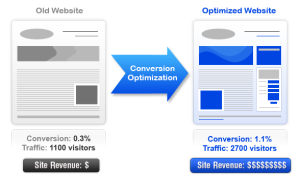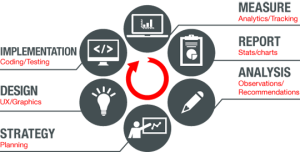Your website is a great opportunity to gather information about your existing customers and potential new customers, but few businesses actually use their websites like the information mills that they are. Too often, businesses just set up their websites, get them as high in the search results as they can, and then hope that the increased online traffic will bring them more sales, instead of actually taking the time to look at their customers’ behavior and use it to create a website that will legitimately drive more site visitors to become customers.

It’s time to stop guessing when it comes to conversion rate optimization. It’s time to stop just using your gut and time to actually make real, informed decisions about what your website should look like and how it should act.
The Danger of Running on Instinct
You might have great instincts, but unless you are a conversion rate expert, you probably don’t have great instincts about how your website’s design, navigation, and content can be used to drive site visitors towards conversion. Most businesses owners use their gut when making decisions about design, navigation, and content, instead of making decisions based on facts.
What’s wrong with using your gut? Your gut doesn’t really know what your customers want or need, especially if that gut isn’t using any data or statistics. You might have a general feeling or understanding of your customer, but even a great looking site will flop if it isn’t built and refined according to the behavior of the people actually using it.
Your Business Is Not the Target Audience
The biggest problem with running on instinct (i.e. simply guessing when it comes to design and content decisions) is that you, your CEO, and your staff are not the target audience of your business. You may love the design, but if it doesn’t work for your site visitors, then it simply does not work. This can be extremely difficult to remember and even more difficult to implement, but it is vitally important.
The customer, in this instance, is the most important. You might be able to get around the website perfectly fine, but you also know your business and you aren’t a customer. Someone coming to your website cold or mostly cold has to be able to navigate it, find the information they want, and be convinced to become a customer.
Are You Measuring the Right Thing?
Having Google Analytics on your website is a great start, but it is not the be all, end all, especially if you do not actually do anything with the heaps of data that Google Analytics provides to you. Do you know why your customers behave how they behave when they arrive on your website? Are you making changes to your website based on that behavior?
So many businesses focus just on the number of page views and do not actually take the time to look at whether or not they are looking at the right metrics or using those metrics correctly. Google Analytics pushes you to focus just on the numbers, specifically on how many people visit each page of your website.
Most businesses owners will assume that a high number of page views is good. But what if you are getting a thousand views on your Contact Us page, but only one person out of those hundred is actually filling out your form? That page is actually not as successful as it may seem at first glance. If you are not measuring your conversions, rather than just your page views, you will never get a full picture of your website or its success.
What Actually Is Conversion Rate Optimization, Then?
Conversion rate optimization is more in depth than search engine optimization, which simply strives to get as many people to your page as possible. Conversion rate optimization maximizes the impact of your website’s pages, so that the people on those pages take the action you want them to take. It, first, takes a look at why your site visitors are not converting and second, changes your website so that your site visitors will convert.
It uses real metrics and real data analysis to observe the behavior of your leads, to figure out why they aren’t becoming your customers, and then to make changes to design, layout, content, etc. so that those who visit your website are more likely to become your customers. In short, it is a data-driven way to make decisions about every aspect of your website that will make it more effective. It’s time to stop guessing when it comes to making those decisions.
Your website is a great opportunity to gather information about your existing customers and potential new customers, but few businesses actually use their websites like the information mills that they are. Too often, businesses just set up their websites, get them as high in the search results as they can, and then hope that the increased online traffic will bring them more sales, instead of actually taking the time to look at their customers’ behavior and use it to create a website that will legitimately drive more site visitors to become customers.

It’s time to stop guessing when it comes to conversion rate optimization. It’s time to stop just using your gut and time to actually make real, informed decisions about what your website should look like and how it should act.
The Danger of Running on Instinct
You might have great instincts, but unless you are a conversion rate expert, you probably don’t have great instincts about how your website’s design, navigation, and content can be used to drive site visitors towards conversion. Most businesses owners use their gut when making decisions about design, navigation, and content, instead of making decisions based on facts.
What’s wrong with using your gut? Your gut doesn’t really know what your customers want or need, especially if that gut isn’t using any data or statistics. You might have a general feeling or understanding of your customer, but even a great looking site will flop if it isn’t built and refined according to the behavior of the people actually using it.
Your Business Is Not the Target Audience
The biggest problem with running on instinct (i.e. simply guessing when it comes to design and content decisions) is that you, your CEO, and your staff are not the target audience of your business. You may love the design, but if it doesn’t work for your site visitors, then it simply does not work. This can be extremely difficult to remember and even more difficult to implement, but it is vitally important.
The customer, in this instance, is the most important. You might be able to get around the website perfectly fine, but you also know your business and you aren’t a customer. Someone coming to your website cold or mostly cold has to be able to navigate it, find the information they want, and be convinced to become a customer.
Are You Measuring the Right Thing?
Having Google Analytics on your website is a great start, but it is not the be all, end all, especially if you do not actually do anything with the heaps of data that Google Analytics provides to you. Do you know why your customers behave how they behave when they arrive on your website? Are you making changes to your website based on that behavior?
So many businesses focus just on the number of page views and do not actually take the time to look at whether or not they are looking at the right metrics or using those metrics correctly. Google Analytics pushes you to focus just on the numbers, specifically on how many people visit each page of your website.
Most businesses owners will assume that a high number of page views is good. But what if you are getting a thousand views on your Contact Us page, but only one person out of those hundred is actually filling out your form? That page is actually not as successful as it may seem at first glance. If you are not measuring your conversions, rather than just your page views, you will never get a full picture of your website or its success.
What Actually Is Conversion Rate Optimization, Then?
Conversion rate optimization is more in depth than search engine optimization, which simply strives to get as many people to your page as possible. Conversion rate optimization maximizes the impact of your website’s pages, so that the people on those pages take the action you want them to take. It, first, takes a look at why your site visitors are not converting and second, changes your website so that your site visitors will convert.
It uses real metrics and real data analysis to observe the behavior of your leads, to figure out why they aren’t becoming your customers, and then to make changes to design, layout, content, etc. so that those who visit your website are more likely to become your customers. In short, it is a data-driven way to make decisions about every aspect of your website that will make it more effective. It’s time to stop guessing when it comes to making those decisions.
Published on December 3, 2015

